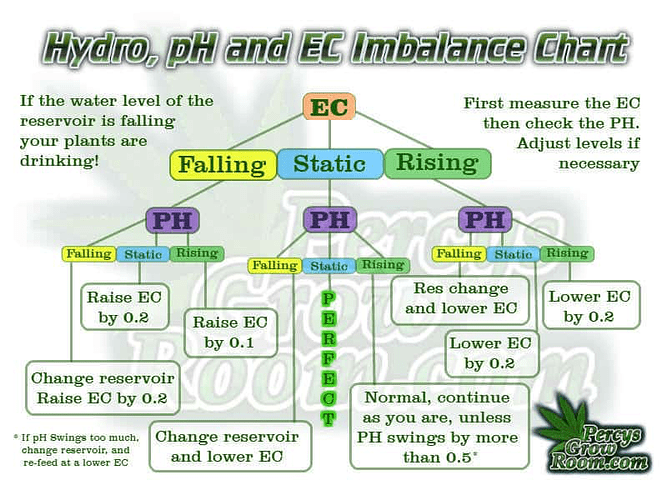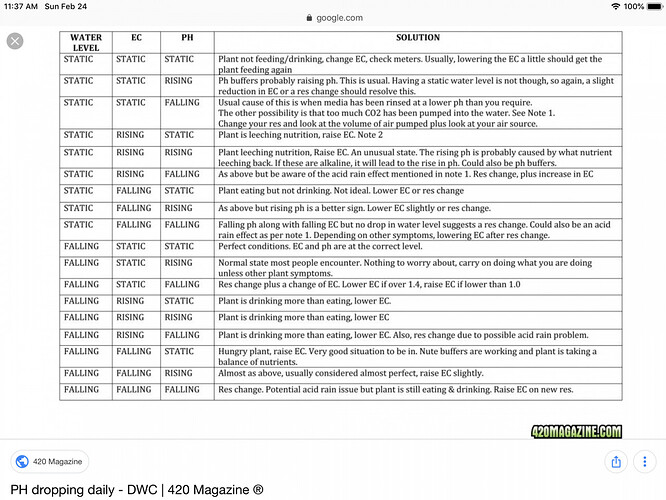Got a question for you guys every week I make up about 113 L of nutrients since the girls have gotten bigger they’re drinking at least 30 to 50 L of water a week and that depletes half the reservoir what I’m thinking is my reservoir has a float valve where I can connect a top of tank if I was to make up enough nutrients that would last 2 to 3 weeks would the nutrients in the top up tank stay good for that long?
My experience (only two grows) is that chemicals in nutes start to precipitate out after a few days. If you’re diligent about stirring the top off tank or if you drop in a little “mixer”, that will get them off the bottom of the tank but you’re still going to have nutes from which some chemicals have fallen out of suspension.
Bigger picture? Plants don’t take up the chemicals in nutes at the same percentage rate. Strains differ, plants take up nutes at different rates depending on the stage of growth, and nute uptake varies as pH varies. All in all, lots of things going on “beneath the waves” to which we’re not privy. With “low turnover” res, you might be able to push it out to three weeks but you’ve got thirsty plants so I’d be surprised if things weren’t out of whack pretty quickly.
What kinds of TDS and pH readings are you seeing as the res ages?
the readings (e.c) in the reservoir generally stay the same or go down p.h generally goes up a couple points but if it goes to far out of whack I use 1.5 pH down to get it back to the recommendations
Sounds like you’re doing things right. Predictability is the key and, with your pH rising gradually until you have to drop it with Down, that’s pretty much textbook.
One thing that I saw mentioned at Percy’s Grow Room, the source for “Son of Wonder Chart” , below, is that the optimal pH in flower is 6.0 vs 5.8 in veg. That’s the only source I’ve read that states that so hat’s off to https://percysgrowroom.com.
Hope this stuff helps even though it looks like things are dialed in. I just checked the cannabis laws in the UK. Ugh. Keep your head down!
I’ve attached a couple of resources from my wanderings around the internet. I refer to them as “WonderChart” and “Son of WonderChart”.
Looks like I can’t upload a text file. The following text is the text of the footnotes for WonderChart:
""Note 1.
When pumping air into a nutrient solution in order to add Dissolved Oxygen, not only oxygen is present, CO2 is also pumped in. If you live near a busy road, this may be higher than normal, so you may get a dropping ph quite often. I have noticed most of the growers who suffer from a falling ph in DWC tend to live in large cities. This may not be a link but it could be.
When CO2 is added to water, it makes it more acidic. This is the precise process which causes acid rain, pollution from power stations etc pouring CO2 into the air, this mixes with the water vapor in clouds causing acid rain.
Note 2.
Most people assume that with a rising EC, it is the plants way of saying, I don’t want more food, here, have some back.
What is actually happening is this.
Plants roots take in water/nutrients through a process called Osmosis. Think of the roots as having their own “internal EC”.
The osmosis process will always try to balance out the EC’s, taking from the higher side of the barrier and giving to the lower part.
So if the EC of the nutrient solution is higher than the “internal EC”, then food & water will flow from the solution to the roots, this is the normal process.
If however, the EC of the solution is lower than the “internal EC”, then the balancing will work the other way and nutrition will be leeched from the roots to the solution.
A res change or increase in EC should resolve depending on the other factors such as ph and water levels.
Note 3.
Nutrients flow around a well hydrated plant much more effectively and faster than one which isn’t as well hydrated.
How can growers use this?
By feeding at lower levels, the plant needs to take on more water in order to get the nutrition it requires.
So by feeding at moderate levels, this forces the plant to drink more.
By drinking more, it is better hydrated, because it is better hydrated, it needs more food, making it eat more.
So feed at moderate levels rather than overly aggressive levels.
The method of pushing the EC until you see signs of nute burn is damaging to the plants and although many growers use this method, I am not a fan though your plants are not mine!
If you disagree with stuff in this post, please PM me. I do not want this thread to end up as a big debate or argument. I am hoping people take it as an honest attempt to help those suffering issues in DWC. The info in this post is my opinion. Before taking any corrective action based on this post, please double check."
http://www.thctalk.com/cannabis-forum/archive/index.php/t-86654.html
"
I agree with everything you said and I also use those charts you linked above
Your on the right track! First the top off reservoir is the answer and they are sized according to your system volume. CCH2O recommends twice the operating volume. If you are in week one then dose your top off tank for week two ( strength and ratios ). In a healthy RDWC system the EC will naturally fall and the PH will naturally rise and usually where those two intersect is when I feed the plants. You don’t want to have a tank for three weeks as you won’t have the right recipe in your tank. Last healthy plants will drink 2 1/2 gallons a day as well as transpire as much.
One caveat that I’ll add to my previous posting - the Wonder Chart was really helpful for me in terms of understanding how a res will tend to change. However, I took it as dogma and that’s not the case. This pertains to the comment that James made, as well.
A res will tend to see rising pH as nutrients are taken up with the exception of times in flower when pH can drop due to the uptake of potassium. pH may well fall as a due to the ion/cation exchange between the roots and the res.
After looking into the “res maintenance issue”, it’s surprising how the practice varies and, as with so many topics in growing cannabis, it’s wise to expect that your situation may be different.
A three week old res may work just fine and a 1 week old res may be depleted…it depends. My res holds 28 gallons of nutes and, dollars to doughnuts, it’s in good shape after three weeks of early veg. In contrast, I swapped my res on Thursday because, after adding back about 10 gallons of RO, EC dropped from 1.72 to 0.88. At that point, I decided to change the res.
In contrast, in one of the videos on the Jack’s website, one of their staff says that he routinely goes “2 to 3 week” between res changes and growers on various cannabis fora have said that they will do one res for veg and one for flower.
A big driver is how a grower tops of the res. For specific reasons, I now top off with RO but my practice has been to top off with RO + nutes. So, how long can you go between res changes? It depends…
Re. water uptake. My grow is two Strawberry Pie autos in a 2’ x 4’ tent in an unheated garage in SoCal. The temp in the tent has ranged from the low 80’s to the mid-70’s and RH has been in 50 to 60 range, with times when I can’t get RH lower which his a pisser since the grow is in mid-flower. One plant dominates the grow, probably for times the size of the other. Annie, the larger plant is 54" tall and 3’ across. Even with that huge amount of plant material, I’m only seeing water uptake of < 2.5 gallons and that’s only since moving into flower. In veg, 1 to 1.5 gallons was that norm. As with pH, 2.5 gallons may be normal for some situations but a grower in a 5 gallon bucket is not going to see ½ of his bucket disappear overnight whereas I fully expect to see 2+ gallons a day for the rest of this grow.
The biggest rule that I’ve learned over the past 18 months of growing is that a lot of the “rules” are not rules, they’re guidelines and that’s not unexpected because growing cannabis can be process-driven it’s farming not manufacturing.
One last thing to add to OC Grower’s input is that the ratios change from week to week as far as the recipe for flowering plants in RDWC. You would have to be really good to get three different recipes into one tank. Also the key here is a homogenized solution to the system. So batch tank mixing and then a delivery pump to transport the solution to the system. If your system is 140 gallons operating volume then your top off res should be at least 150 gallons and mixed for the following weeks recipe. I have found that it will naturally steer the system to the targets and keep numbers all in line. This methodology is giving the plants more of what they want rather than trying to adjust something and fix a problem. The last thing is temperature of your solution in tanks. Lower than 68 degrees and your asking for problems with bacterial bloom as well as pathogens ect. Clean chelated nutrients makes the plants happy and the care taker!!! Best of luck


